Advertising pictures, posters and vietnamese woodblock-Printing labels in the period 1946 - 1954
In Vietnamese graphic arts, advertising pictures, posters, and engravings
printed in wood from 1946-1954 have made important contributions in many aspects of
politics, culture and arts. The works of this period not only reflected the historical appearance
of a people in words, images and techniques expressing the specificity of wood carvings in the
general development of art, but also contribute to confirm the imprint of this material during
the development of applied art of Vietnam
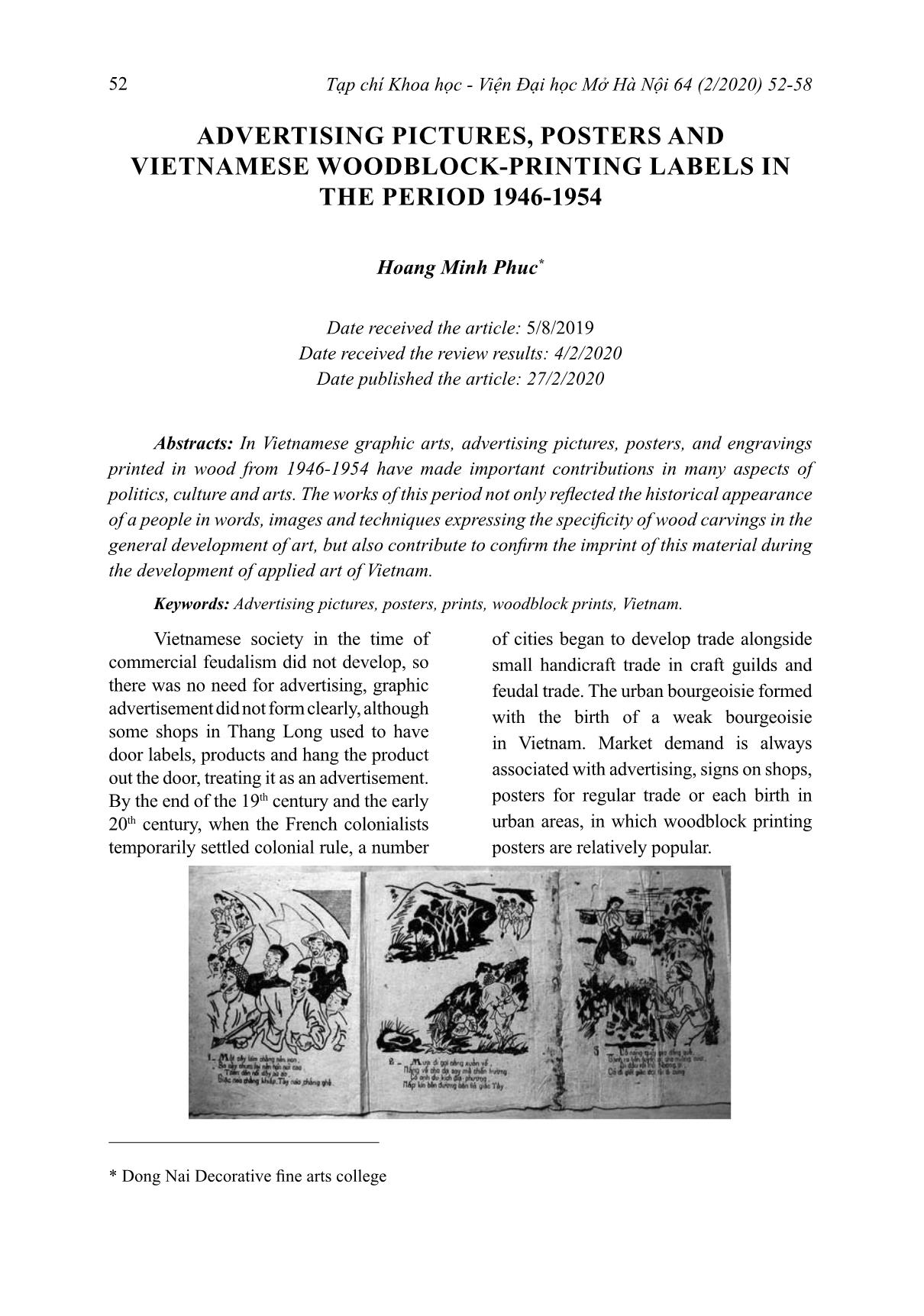
Trang 1
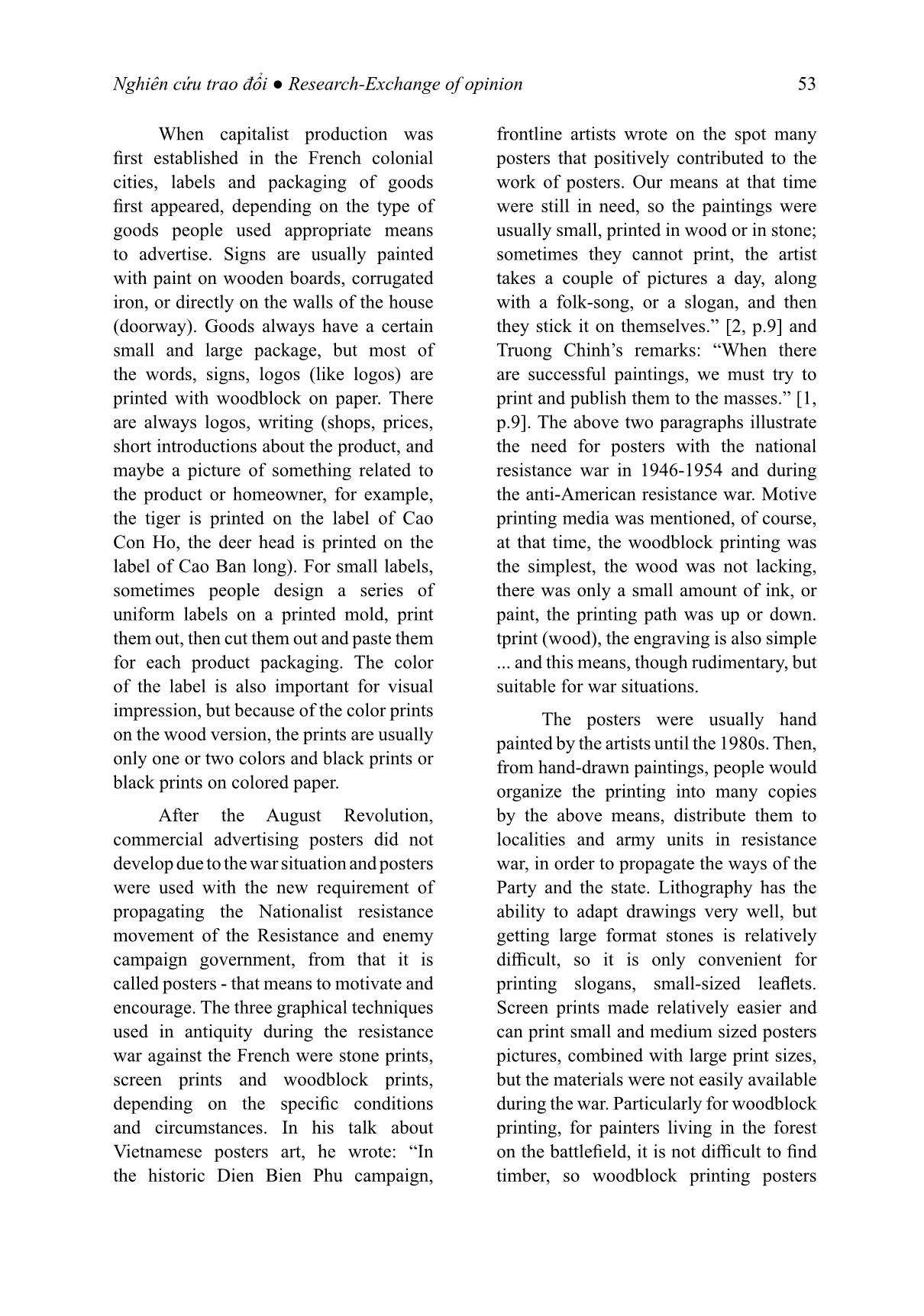
Trang 2
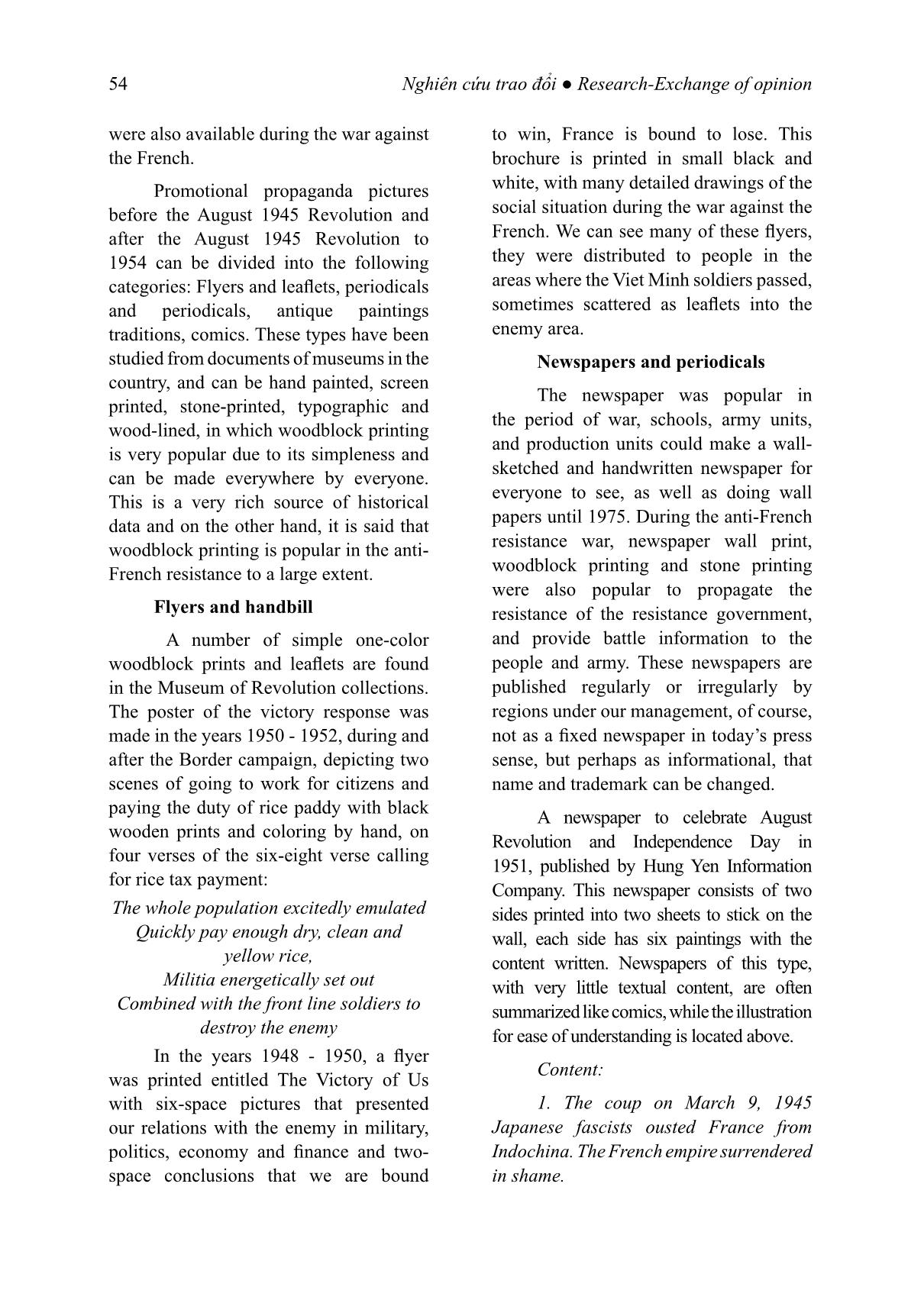
Trang 3
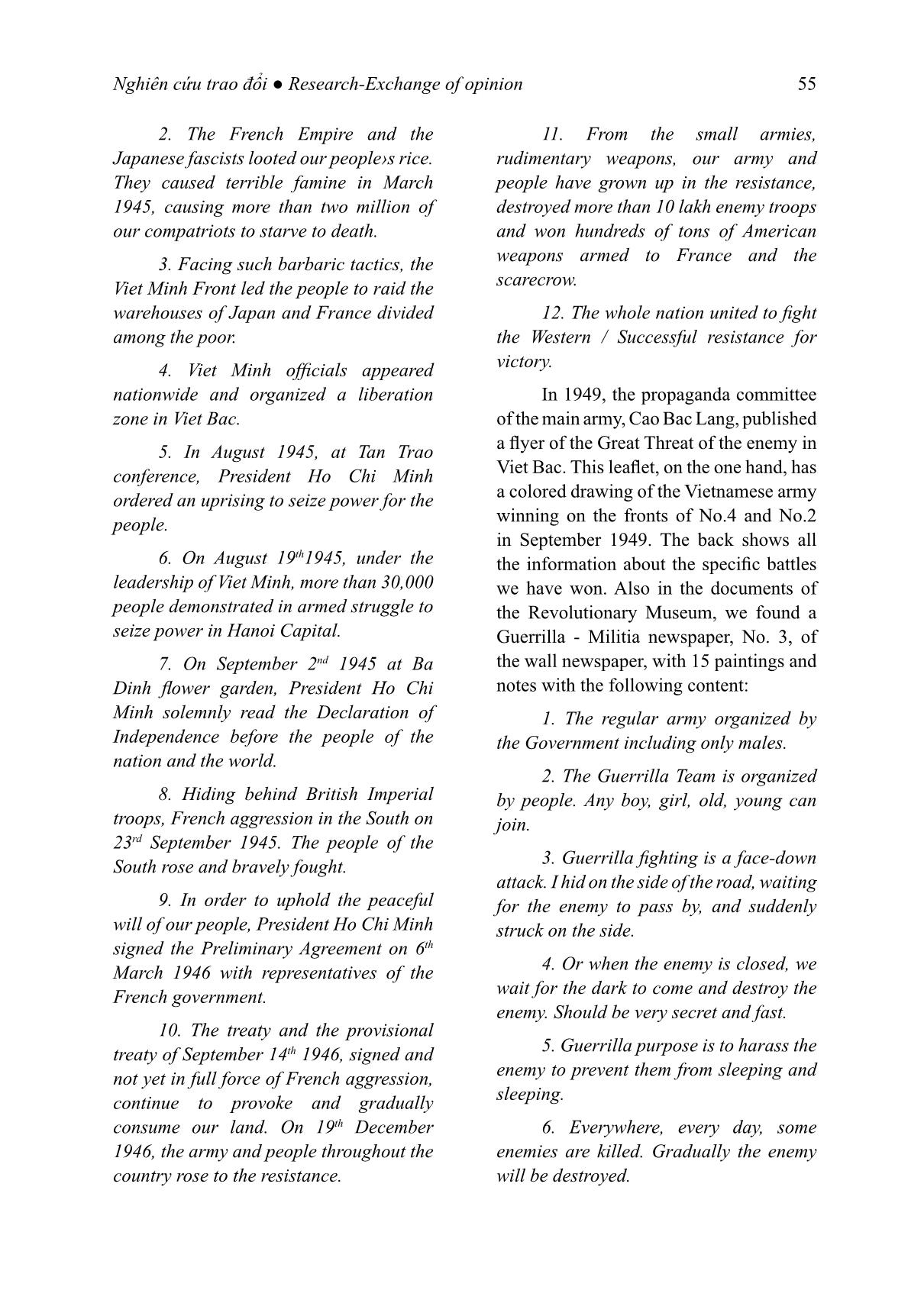
Trang 4
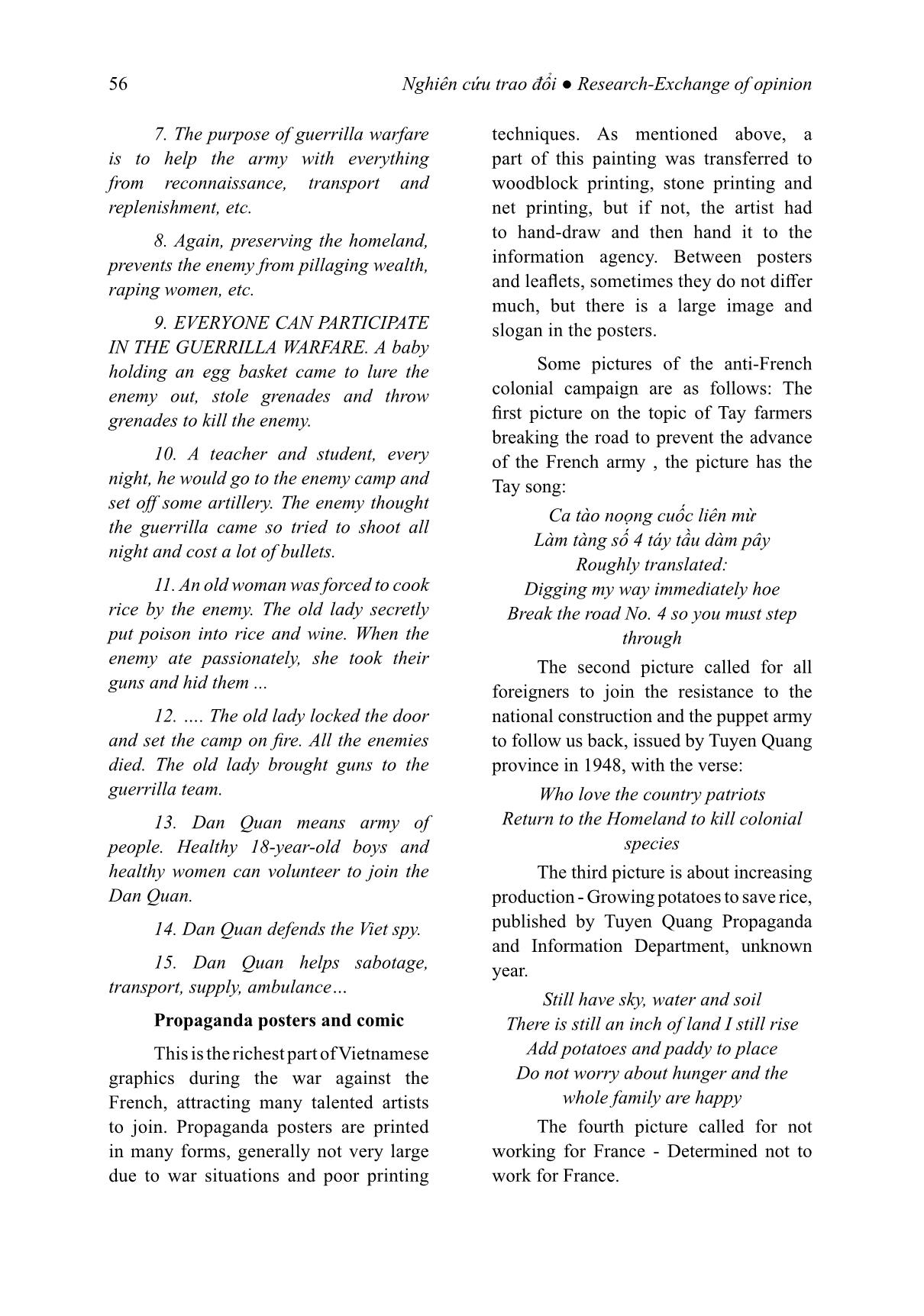
Trang 5
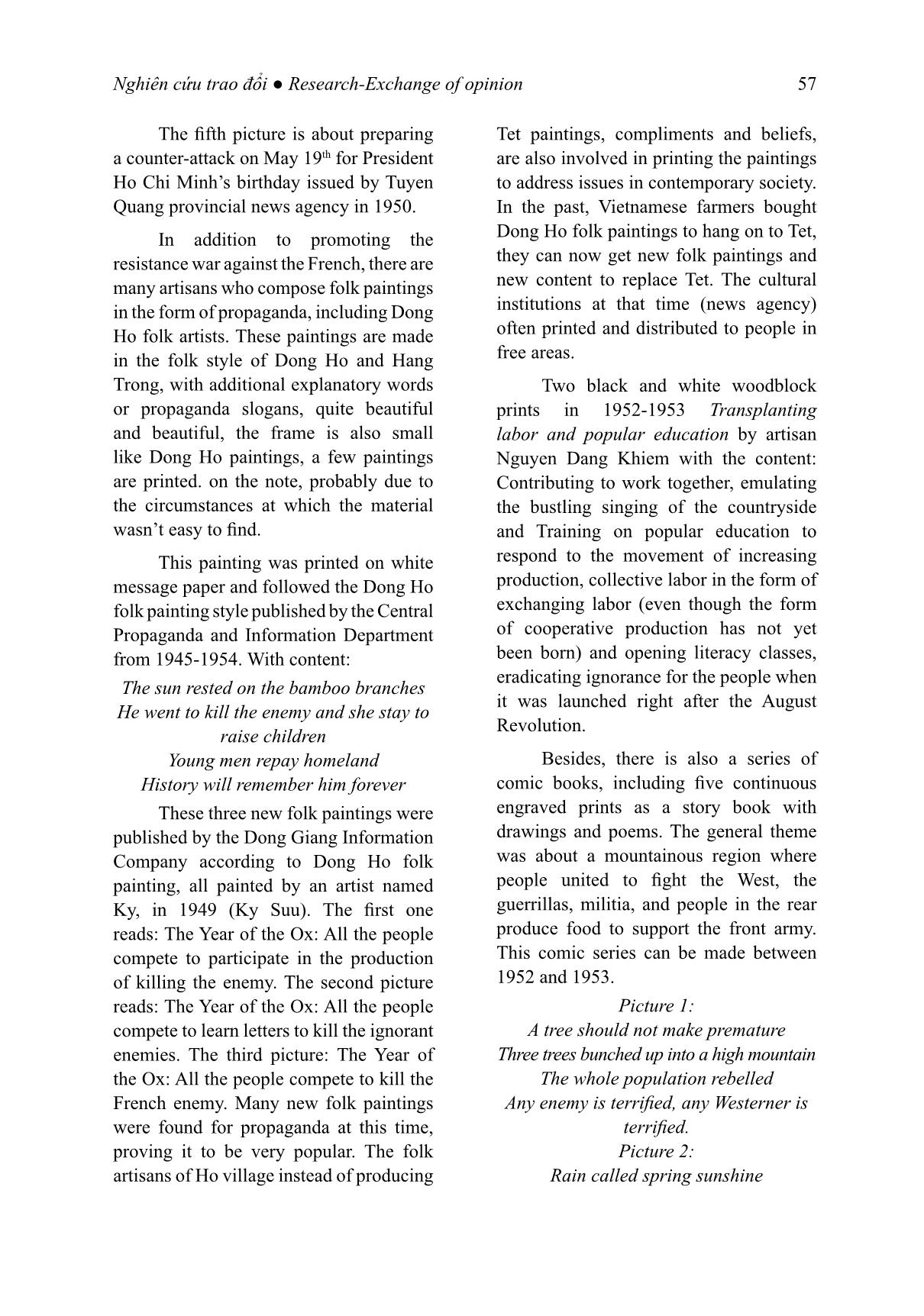
Trang 6
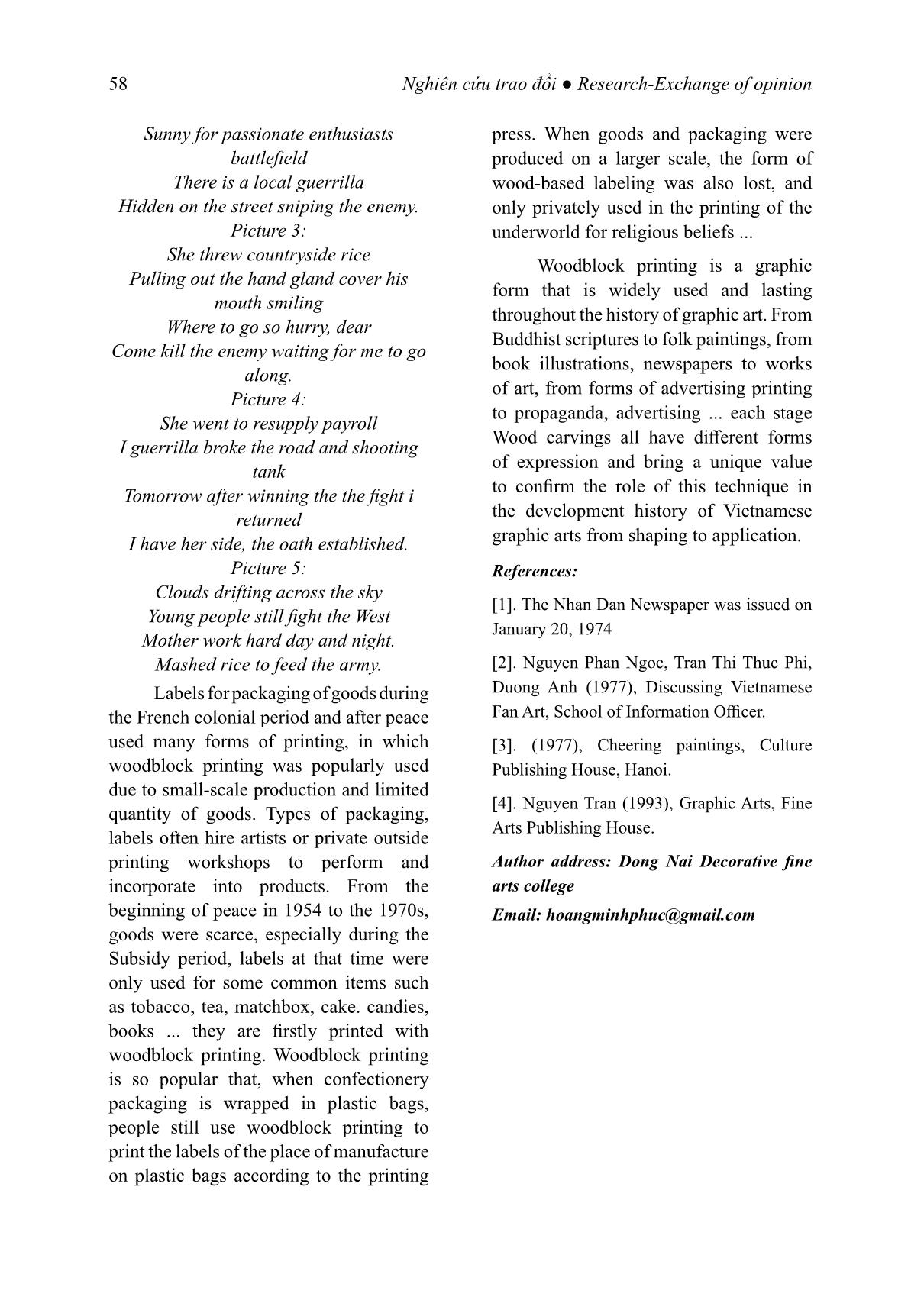
Trang 7
Bạn đang xem tài liệu "Advertising pictures, posters and vietnamese woodblock-Printing labels in the period 1946 - 1954", để tải tài liệu gốc về máy hãy click vào nút Download ở trên
Tóm tắt nội dung tài liệu: Advertising pictures, posters and vietnamese woodblock-Printing labels in the period 1946 - 1954
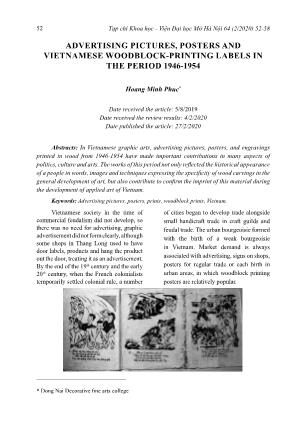
52 Nghiên cứu trao đổi ● Research-Exchange of opinion ADVERTISING PICTURES, POSTERS AND VIETNAMESE WOODBLOCK-PRINTING LABELS IN THE PERIOD 1946-1954 Hoang Minh Phuc* Date received the article: 5/8/2019 Date received the review results: 4/2/2020 Date published the article: 27/2/2020 Abstracts: In Vietnamese graphic arts, advertising pictures, posters, and engravings printed in wood from 1946-1954 have made important contributions in many aspects of politics, culture and arts. The works of this period not only refl ected the historical appearance of a people in words, images and techniques expressing the specifi city of wood carvings in the general development of art, but also contribute to confi rm the imprint of this material during the development of applied art of Vietnam. Keywords: Advertising pictures, posters, prints, woodblock prints, Vietnam. * Dong Nai Decorative fi ne arts college Tạp chí Khoa học - Viện Đại học Mở Hà Nội 64 (2/2020) 52-58 Vietnamese society in the time of commercial feudalism did not develop, so there was no need for advertising, graphic advertisement did not form clearly, although some shops in Thang Long used to have door labels, products and hang the product out the door, treating it as an advertisement. By the end of the 19th century and the early 20th century, when the French colonialists temporarily settled colonial rule, a number of cities began to develop trade alongside small handicraft trade in craft guilds and feudal trade. The urban bourgeoisie formed with the birth of a weak bourgeoisie in Vietnam. Market demand is always associated with advertising, signs on shops, posters for regular trade or each birth in urban areas, in which woodblock printing posters are relatively popular. 53Nghiên cứu trao đổi ● Research-Exchange of opinion When capitalist production was fi rst established in the French colonial cities, labels and packaging of goods fi rst appeared, depending on the type of goods people used appropriate means to advertise. Signs are usually painted with paint on wooden boards, corrugated iron, or directly on the walls of the house (doorway). Goods always have a certain small and large package, but most of the words, signs, logos (like logos) are printed with woodblock on paper. There are always logos, writing (shops, prices, short introductions about the product, and maybe a picture of something related to the product or homeowner, for example, the tiger is printed on the label of Cao Con Ho, the deer head is printed on the label of Cao Ban long). For small labels, sometimes people design a series of uniform labels on a printed mold, print them out, then cut them out and paste them for each product packaging. The color of the label is also important for visual impression, but because of the color prints on the wood version, the prints are usually only one or two colors and black prints or black prints on colored paper. After the August Revolution, commercial advertising posters did not develop due to the war situation and posters were used with the new requirement of propagating the Nationalist resistance movement of the Resistance and enemy campaign government, from that it is called posters - that means to motivate and encourage. The three graphical techniques used in antiquity during the resistance war against the French were stone prints, screen prints and woodblock prints, depending on the specifi c conditions and circumstances. In his talk about Vietnamese posters art, he wrote: “In the historic Dien Bien Phu campaign, frontline artists wrote on the spot many posters that positively contributed to the work of posters. Our means at that time were still in need, so the paintings were usually small, printed in wood or in stone; sometimes they cannot print, the artist takes a couple of pictures a day, along with a folk-song, or a slogan, and then they stick it on themselves.” [2, p.9] and Truong Chinh’s remarks: “When there are successful paintings, we must try to print and publish them to the masses.” [1, p.9]. The above two paragraphs illustrate the need for posters with the national resistance war in 1946-1954 and during the anti-American resistance war. Motive printing media was mentioned, of course, at that time, the woodblock printing was the simplest, the wood was not lacking, there was only a small amount of ink, or paint, the printing path was up or down. tprint (wood), the engraving is also simple ... and this means, though rudimentary, but suitable for war situations. The posters were usually hand painted by the artists until the 1980s. Then, from hand-drawn paintings, people would organize the printing into many copies by the above means, distribute them to localities and army units in resistance war, in order to propagate the ways of the Party and the state. Lithography has the ability to adapt drawings very well, but getting large format stones is relatively diffi cult, so it is only convenient for printing slogans, small-sized leafl ets. Screen prints made relatively easier and can print small and medium sized posters pictures, combined with large print sizes, but the materials were not easily available during the war. Particularly for woodblock printing, for painters living in the forest on the battlefi eld, it is not diffi cult to fi nd timber, so woodblock printing posters 54 Nghiên cứu trao đổi ● Research-Exchange of opinion were also available during the war against the French. Promotional propaganda pictures before the August 1945 Revolution and after the August 1945 Revolution to 1954 can be divided into the following categories: Flyers and leafl ets, periodicals and periodicals, antique paintings traditions, comics. These types have been studied from documents of museums in the ... and yellow rice, Militia energetically set out Combined with the front line soldiers to destroy the enemy In the years 1948 - 1950, a fl yer was printed entitled The Victory of Us with six-space pictures that presented our relations with the enemy in military, politics, economy and fi nance and two- space conclusions that we are bound to win, France is bound to lose. This brochure is printed in small black and white, with many detailed drawings of the social situation during the war against the French. We can see many of these fl yers, they were distributed to people in the areas where the Viet Minh soldiers passed, sometimes scattered as leafl ets into the enemy area. Newspapers and periodicals The newspaper was popular in the period of war, schools, army units, and production units could make a wall- sketched and handwritten newspaper for everyone to see, as well as doing wall papers until 1975. During the anti-French resistance war, newspaper wall print, woodblock printing and stone printing were also popular to propagate the resistance of the resistance government, and provide battle information to the people and army. These newspapers are published regularly or irregularly by regions under our management, of course, not as a fi xed newspaper in today’s press sense, but perhaps as informational, that name and trademark can be changed. A newspaper to celebrate August Revolution and Independence Day in 1951, published by Hung Yen Information Company. This newspaper consists of two sides printed into two sheets to stick on the wall, each side has six paintings with the content written. Newspapers of this type, with very little textual content, are often summarized like comics, while the illustration for ease of understanding is located above. Content: 1. The coup on March 9, 1945 Japanese fascists ousted France from Indochina. The French empire surrendered in shame. 55Nghiên cứu trao đổi ● Research-Exchange of opinion 2. The French Empire and the Japanese fascists looted our people›s rice. They caused terrible famine in March 1945, causing more than two million of our compatriots to starve to death. 3. Facing such barbaric tactics, the Viet Minh Front led the people to raid the warehouses of Japan and France divided among the poor. 4. Viet Minh offi cials appeared nationwide and organized a liberation zone in Viet Bac. 5. In August 1945, at Tan Trao conference, President Ho Chi Minh ordered an uprising to seize power for the people. 6. On August 19th1945, under the leadership of Viet Minh, more than 30,000 people demonstrated in armed struggle to seize power in Hanoi Capital. 7. On September 2nd 1945 at Ba Dinh fl ower garden, President Ho Chi Minh solemnly read the Declaration of Independence before the people of the nation and the world. 8. Hiding behind British Imperial troops, French aggression in the South on 23rd September 1945. The people of the South rose and bravely fought. 9. In order to uphold the peaceful will of our people, President Ho Chi Minh signed the Preliminary Agreement on 6th March 1946 with representatives of the French government. 10. The treaty and the provisional treaty of September 14th 1946, signed and not yet in full force of French aggression, continue to provoke and gradually consume our land. On 19th December 1946, the army and people throughout the country rose to the resistance. 11. From the small armies, rudimentary weapons, our army and people have grown up in the resistance, destroyed more than 10 lakh enemy troops and won hundreds of tons of American weapons armed to France and the scarecrow. 12. The whole nation united to fi ght the Western / Successful resistance for victory. In 1949, the propaganda committee of the main army, Cao Bac Lang, published a fl yer of the Great Threat of the enemy in Viet Bac. This leafl et, on the one hand, has a colored drawing of the Vietnamese army winning on the fronts of No.4 and No.2 in September 1949. The back shows all the information about the specifi c battles we have won. Also in the documents of the Revolutionary Museum, we found a Guerrilla - Militia newspaper, No. 3, of the wall newspaper, with 15 paintings and notes with the following content: 1. The regular army organized by the Government including only males. 2. The Guerrilla Team is organized by people. Any boy, girl, old, young can join. 3. Guerrilla fi ghting is a face-down attack. I hid on the side of the road, waiting for the enemy to pass by, and suddenly struck on the side. 4. Or when the enemy is closed, we wait for the dark to come and destroy the enemy. Should be very secret and fast. 5. Guerrilla purpose is to harass the enemy to prevent them from sleeping and sleeping. 6. Everywhere, every day, some enemies are killed. Gradually the enemy will be destroyed. 56 Nghiên cứu trao đổi ● Research-Exchange of opinion 7. The purpose of guerrilla warfare is to help the army with everything from reconnaissance, transport and replenishment, etc. 8. Again, preserving the homeland, prevents the enemy from pillaging wealth, raping women, etc. 9. EVERYONE CAN PARTICIPATE IN THE GUERRILLA WARFARE. A baby holding an egg basket came to lure the enemy out, stole grenades and throw grenades to kill the enemy. 10. A teacher and student, every night, he would go to the enemy camp and set off some artillery. The enemy thought the guerrilla came so tried to shoot all night and cost a lot of bullets. 11. An old woman was forced to cook rice by the enemy. The old lady secretly put poison into rice and wine. When the enemy ate passionately, she took their guns and hid them ... 12. . The old lady locked the door and set the camp on fi re. All the enemies died. The old lady brought guns to the guerrilla team. 13. Dan Quan means army of people. Healthy 18-year-old boys and healthy women can volunteer to join the Dan Quan. 14. Dan Quan defends the Viet spy. 15. Dan Quan helps sabotage, transport, supply, ambulance Propaganda posters and comic This is the richest part of Vietnamese graphics during the war against the French, attracting many talented artists to join. Propaganda posters are printed in many forms, generally not very large due to war situations and poor printing techniques. As mentioned above, a part of this painting was transferred to woodblock printing, stone printing and net printing, but if not, the artist had to hand-draw and then hand it to the information agency. Between posters and leafl ets, sometimes they do not diff er much, but there is a large image and slogan in the posters. Some pictures of the anti-French colonial campaign are as follows: The fi rst picture on the topic of Tay farmers breaking the road to prevent the advance of the French army , the picture has the Tay song: Ca tào noọng cuốc liên mừ Làm tàng số 4 táy tầu dàm pây Roughly translated: Digging my way immediately hoe Break the road No. 4 so you must step through The second picture called for all foreigners to join the resistance to the national construction and the puppet army to follow us back, issued by Tuyen Quang province in 1948, with the verse: Who love the country patriots Return to the Homeland to kill colonial species The third picture is about increasing production - Growing potatoes to save rice, published by Tuyen Quang Propaganda and Information Department, unknown year. Still have sky, water and soil There is still an inch of land I still rise Add potatoes and paddy to place Do not worry about hunger and the whole family are happy The fourth picture called for not working for France - Determined not to work for France. 57Nghiên cứu trao đổi ● Research-Exchange of opinion The fi fth picture is about preparing a counter-attack on May 19th for President Ho Chi Minh’s birthday issued by Tuyen Quang provincial news agency in 1950. In addition to promoting the resistance war against the French, there are many artisans who compose folk paintings in the form of propaganda, including Dong Ho folk artists. These paintings are made in the folk style of Dong Ho and Hang Trong, with additional explanatory words or propaganda slogans, quite beautiful and beautiful, the frame is also small like Dong Ho paintings, a few paintings are printed. on the note, probably due to the circumstances at which the material wasn’t easy to fi nd. This painting was printed on white message paper and followed the Dong Ho folk painting style published by the Central Propaganda and Information Department from 1945-1954. With content: The sun rested on the bamboo branches He went to kill the enemy and she stay to raise children Young men repay homeland History will remember him forever These three new folk paintings were published by the Dong Giang Information Company according to Dong Ho folk painting, all painted by an artist named Ky, in 1949 (Ky Suu). The fi rst one reads: The Year of the Ox: All the people compete to participate in the production of killing the enemy. The second picture reads: The Year of the Ox: All the people compete to learn letters to kill the ignorant enemies. The third picture: The Year of the Ox: All the people compete to kill the French enemy. Many new folk paintings were found for propaganda at this time, proving it to be very popular. The folk artisans of Ho village instead of producing Tet paintings, compliments and beliefs, are also involved in printing the paintings to address issues in contemporary society. In the past, Vietnamese farmers bought Dong Ho folk paintings to hang on to Tet, they can now get new folk paintings and new content to replace Tet. The cultural institutions at that time (news agency) often printed and distributed to people in free areas. Two black and white woodblock prints in 1952-1953 Transplanting labor and popular education by artisan Nguyen Dang Khiem with the content: Contributing to work together, emulating the bustling singing of the countryside and Training on popular education to respond to the movement of increasing production, collective labor in the form of exchanging labor (even though the form of cooperative production has not yet been born) and opening literacy classes, eradicating ignorance for the people when it was launched right after the August Revolution. Besides, there is also a series of comic books, including fi ve continuous engraved prints as a story book with drawings and poems. The general theme was about a mountainous region where people united to fi ght the West, the guerrillas, militia, and people in the rear produce food to support the front army. This comic series can be made between 1952 and 1953. Picture 1: A tree should not make premature Three trees bunched up into a high mountain The whole population rebelled Any enemy is terrifi ed, any Westerner is terrifi ed. Picture 2: Rain called spring sunshine 58 Nghiên cứu trao đổi ● Research-Exchange of opinion Sunny for passionate enthusiasts battlefi eld There is a local guerrilla Hidden on the street sniping the enemy. Picture 3: She threw countryside rice Pulling out the hand gland cover his mouth smiling Where to go so hurry, dear Come kill the enemy waiting for me to go along. Picture 4: She went to resupply payroll I guerrilla broke the road and shooting tank Tomorrow after winning the the fi ght i returned I have her side, the oath established. Picture 5: Clouds drifting across the sky Young people still fi ght the West Mother work hard day and night. Mashed rice to feed the army. Labels for packaging of goods during the French colonial period and after peace used many forms of printing, in which woodblock printing was popularly used due to small-scale production and limited quantity of goods. Types of packaging, labels often hire artists or private outside printing workshops to perform and incorporate into products. From the beginning of peace in 1954 to the 1970s, goods were scarce, especially during the Subsidy period, labels at that time were only used for some common items such as tobacco, tea, matchbox, cake. candies, books ... they are fi rstly printed with woodblock printing. Woodblock printing is so popular that, when confectionery packaging is wrapped in plastic bags, people still use woodblock printing to print the labels of the place of manufacture on plastic bags according to the printing press. When goods and packaging were produced on a larger scale, the form of wood-based labeling was also lost, and only privately used in the printing of the underworld for religious beliefs ... Woodblock printing is a graphic form that is widely used and lasting throughout the history of graphic art. From Buddhist scriptures to folk paintings, from book illustrations, newspapers to works of art, from forms of advertising printing to propaganda, advertising ... each stage Wood carvings all have diff erent forms of expression and bring a unique value to confi rm the role of this technique in the development history of Vietnamese graphic arts from shaping to application. References: [1]. The Nhan Dan Newspaper was issued on January 20, 1974 [2]. Nguyen Phan Ngoc, Tran Thi Thuc Phi, Duong Anh (1977), Discussing Vietnamese Fan Art, School of Information Offi cer. [3]. (1977), Cheering paintings, Culture Publishing House, Hanoi. [4]. Nguyen Tran (1993), Graphic Arts, Fine Arts Publishing House. Author address: Dong Nai Decorative fi ne arts college Email: hoangminhphuc@gmail.com
File đính kèm:
 advertising_pictures_posters_and_vietnamese_woodblock_printi.pdf
advertising_pictures_posters_and_vietnamese_woodblock_printi.pdf

